
Musical theatre is a form of theatrical performance that combines songs, spoken dialogue, acting and dance. The story and emotional content of a musical – humor, pathos, love, anger – are communicated through words, music, movement and technical aspects of the entertainment as an integrated whole. Although musical theatre overlaps with other theatrical forms like opera and dance, it may be distinguished by the equal importance given to the music as compared with the dialogue, movement and other elements. Since the early 20th century, musical theatre stage works have generally been called, simply, musicals.

Oscar Greeley Clendenning Hammerstein II was an American lyricist, librettist, theatrical producer, and director in the musical theater for almost 40 years. He won eight Tony Awards and two Academy Awards for Best Original Song. Many of his songs are standard repertoire for vocalists and jazz musicians. He co-wrote 850 songs.
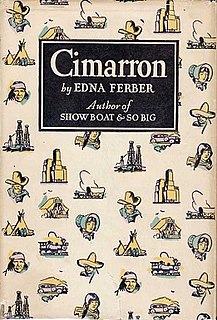
Cimarron is a novel by Edna Ferber, published in April 1930 and based on development in Oklahoma after the Land Rush. The book was adapted into a critically acclaimed film of the same name, released in 1931 through RKO Pictures. The story was again adapted for the screen by Metro-Goldwyn-Mayer and was released in 1960, to meager success.
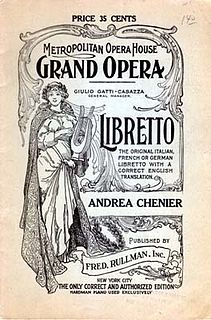
A libretto is the text used in, or intended for, an extended musical work such as an opera, operetta, masque, oratorio, cantata or musical. The term libretto is also sometimes used to refer to the text of major liturgical works, such as the Mass, requiem and sacred cantata, or the story line of a ballet.
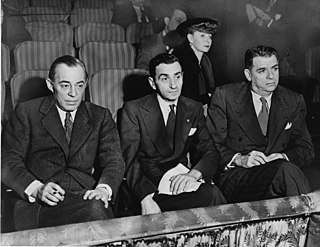
Rodgers and Hammerstein refers to the duo of composer Richard Rodgers (1902–1979) and lyricist-dramatist Oscar Hammerstein II (1895–1960), who together were an influential, innovative and successful American musical theatre writing team. They created a string of popular Broadway musicals in the 1940s and 1950s, initiating what is considered the "golden age" of musical theatre. Five of their Broadway shows, Oklahoma!, Carousel, South Pacific, The King and I and The Sound of Music, were outstanding successes, as was the television broadcast of Cinderella (1957). Of the other four shows that the team produced on Broadway during their lifetimes, Flower Drum Song was well-received, and none was an outright flop. Most of their shows have received frequent revivals around the world, both professional and amateur. Among the many accolades their shows garnered were thirty-four Tony Awards, fifteen Academy Awards, two Pulitzer Prizes and two Grammy Awards.
Sir Trevor Robert Nunn is a British theatre director. Nunn has been the Artistic Director for the Royal Shakespeare Company, the Royal National Theatre, and, currently, the Theatre Royal, Haymarket. He has directed dramas for the stage, like Macbeth, as well as opera and musicals, such as Cats (1981) and Les Misérables (1985).
A tie-in work is a work of fiction or other product based on a media property such as a film, video game, television series, board game, web site, role-playing game or literary property. Tie-ins are authorized by the owners of the original property, and are a form of cross-promotion used primarily to generate additional income from that property and to promote its visibility.
Lee Hall is an English playwright, television writer, screenwriter, and lyricist. He is best known for writing the 2000 film Billy Elliot and the book and lyrics for its stage musical adaptation, as well as the 2019 film Rocketman and 2007 play The Pitmen Painters.
Woyzeck is a stage play written by Georg Büchner. He left the work incomplete at his death, but it has been posthumously "finished" by a variety of authors, editors and translators. Woyzeck deals with the dehumanising effects of doctors and the military on a young man's life. It is often seen as 'working class' tragedy, though it can also be viewed as having another dimension, portraying the 'perennial tragedy of human jealousy'. The play was admired both by the German naturalist Gerhart Hauptmann and, subsequently, by expressionist playwrights. Woyzeck has become one of the most performed and influential plays in the German theatre repertory.
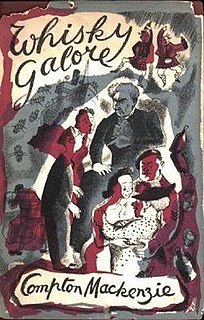
Whisky Galore is a novel written by Compton Mackenzie, published in 1947. It was adapted for the cinema under the title Whisky Galore!.
A film adaptation is the transfer of a work or story, in whole or in part, to a feature film. Although often considered a type of derivative work, film adaptation has been conceptualized recently by academic scholars such as Robert Stam as a dialogic process.

Dorothy Heyward was an American playwright.
Stage-to-film is a term used when describing a motion picture that has been adapted from a stage play. There have been stage-to-film adaptations since the beginning of motion pictures. Many of them have been nominated for, or have won, awards.

Literary adaptation is the adapting of a literary source to another genre or medium, such as a film, stage play, or video game.
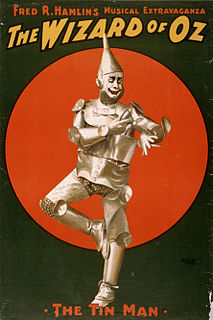
The Wonderful Wizard of Oz is a 1900 children's novel written by American author L. Frank Baum. Since its first publication in 1900, it has been adapted many times: for film, television, theatre, books, comics, games, and other media.
A Christmas Carol, the popular 1843 novella by Charles Dickens (1812–1870), is one of the British author's best-known works. It is the story of Ebenezer Scrooge, a greedy miser who hates Christmas, but is transformed into a caring, kindly person through the visitations of four ghosts. The classic work has been dramatised and adapted countless times for virtually every medium and performance genre, and new versions appear regularly.
A motion comic is a form of animation combining elements of print comic books and animation. Individual panels are expanded into a full shot while sound effects, voice acting, and animation are added to the original artwork. Text boxes, speech bubbles and the onomatopoeia are typically removed to feature more of the original artwork being animated. Motion comics are often released as short serials covering a story arc of a long running series or animating a single release of a graphic novel. Single release issues of a story arc are converted into ten- to twenty-minute-long episodes depending on content.

Miracle on 34th Street (1947) is a best-selling novella by Valentine Davies, based on the story he wrote for the 1947 film with the same name, which earned him an Academy Award for Best Story. After having written the story for the film, Valentine Davies did a novelization of it, which was published as a 120-page novella by Harcourt Brace & Company in conjunction with the film release.
An adaptation is a transfer of a work of art from one style to another.









